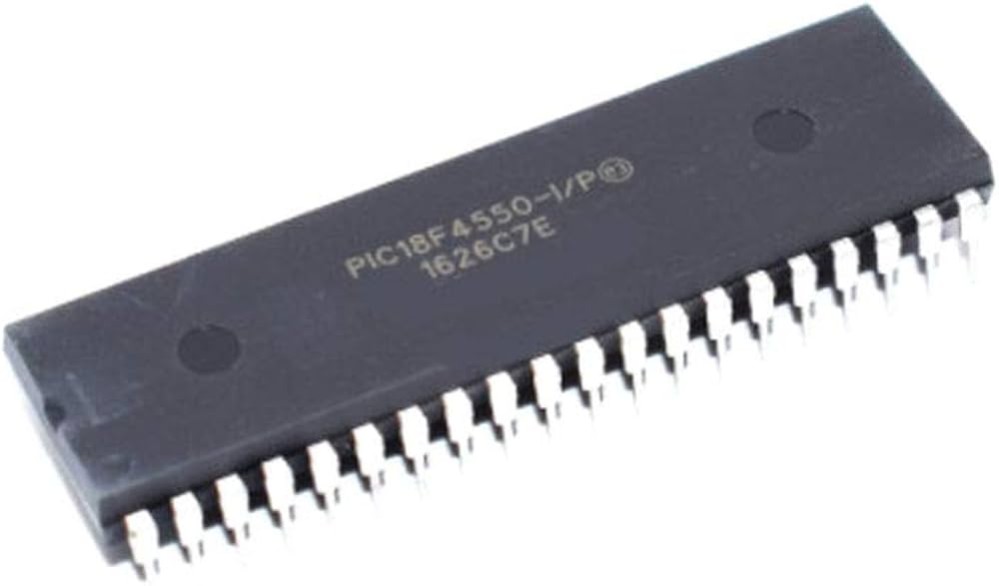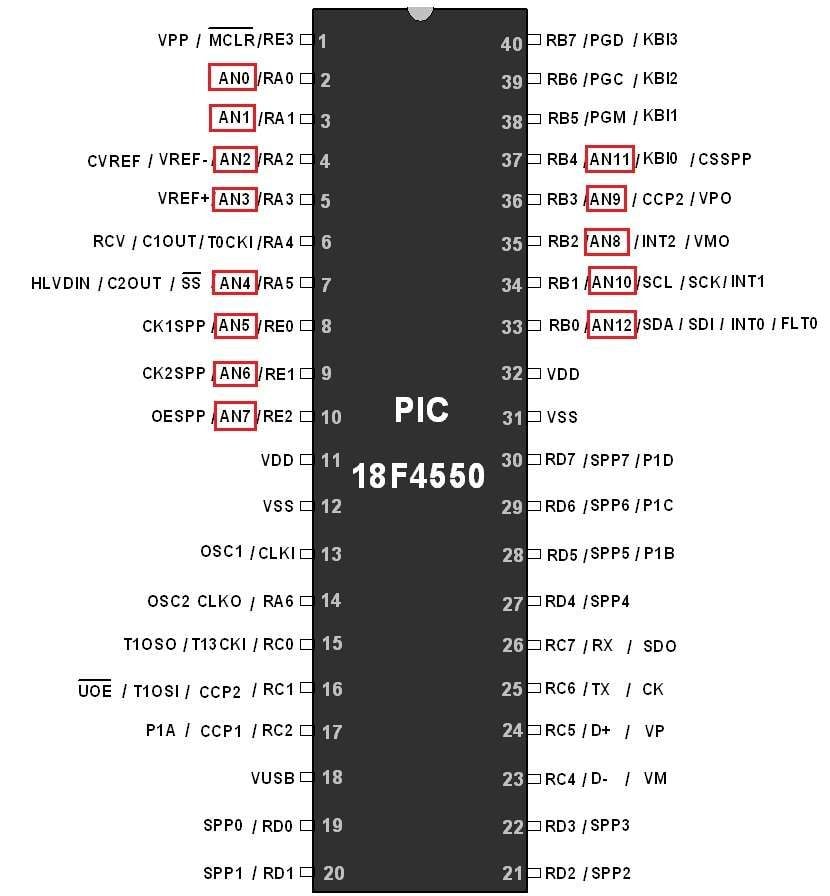





PIC 18f4550 IC
The PIC18F4550-I/ML is a high-performance PIC18 family 8-bit powerful (200 nanosecond instruction execution) yet easy-to-program CMOS flash based Microcontroller packs powerful PIC®(RISC) architecture with up to 16 MIPS of processing power.
₹ 549 ₹649
649
Add FAQ
The PIC18F4550 is a microcontroller from Microchip Technology that belongs to the PIC18 family. It's widely used in embedded systems and electronics projects due to its powerful features, versatility, and ease of use. Here’s a detailed overview of the PIC18F4550 microcontroller:
Key Features of PIC18F4550:
-
Microcontroller Family:
- The PIC18F4550 is part of the PIC18 family of microcontrollers, designed for high-performance applications with low power consumption and enhanced features.
-
Core Architecture:
- It uses the 8-bit RISC architecture (Reduced Instruction Set Computing), which allows fast execution of instructions.
- Harvard Architecture: It uses a separate memory space for program code and data, allowing efficient instruction processing.
-
Flash Memory:
- 32KB of Flash Program Memory: This is where the program code is stored.
- 2KB of SRAM (Data Memory): Used for storing variables and temporary data during execution.
- 256B of EEPROM: Electrically erasable and programmable memory used for non-volatile data storage.
-
Clock Speed:
- The PIC18F4550 operates with a maximum clock speed of 48 MHz, which allows for quick processing and execution of tasks.
- The clock is typically driven by an external crystal or oscillator, but it can also use an internal clock source.
-
Input/Output Pins:
- The microcontroller has 40 pins, with 35 I/O pins that can be configured as input or output for interfacing with other devices.
- It has multiple general-purpose I/O (GPIO) pins for connecting sensors, LEDs, motors, or other peripherals.
-
USB Interface:
- One of the standout features of the PIC18F4550 is its built-in full-speed USB 2.0 interface (12 Mbps).
- This allows direct communication with USB devices (e.g., connecting to computers, USB keyboards, mice, etc.) without the need for external USB interface ICs.
-
Analog-to-Digital Converter (ADC):
- The PIC18F4550 comes with a 10-bit ADC with 16 channels, allowing it to read analog signals from sensors or other devices and convert them into digital form for processing.
-
Timers and Counters:
- It has multiple timers (Timer0, Timer1, Timer2, etc.) and PWM outputs (Pulse Width Modulation), which are useful for generating accurate time delays, creating pulse signals, and controlling motors or LEDs.
-
Serial Communication:
- The PIC18F4550 supports USART (Universal Synchronous Asynchronous Receiver Transmitter) for serial communication (RS-232, UART), as well as SPI (Serial Peripheral Interface) and I2C (Inter-Integrated Circuit) interfaces for communication with other microcontrollers or peripherals.
-
Interrupts:
- The microcontroller supports interrupts from various sources, such as external pins, timers, or serial communication, allowing for responsive and efficient handling of events.
-
Low Power Consumption:
- The PIC18F4550 is designed for low power consumption, with different operating modes to reduce energy usage in battery-powered applications.
-
Built-in Watchdog Timer:
- It includes a watchdog timer that can reset the microcontroller if the program crashes or hangs, helping to maintain reliability in critical applications.
Pinout and Configuration:
The PIC18F4550 has a 40-pin package with the following features:
- Power: VDD (positive voltage), VSS (ground), and an optional VCAP (voltage regulator capacitor).
- I/O Pins: 35 I/O pins that are configurable as input or output.
- USB Pins: Special pins for USB data (D+ and D-) communication.
- Analog Pins: Some of the I/O pins can function as analog inputs, connected to the built-in ADC channels.
Common Applications of the PIC18F4550:
-
USB Devices:
- Due to its built-in USB interface, the PIC18F4550 is widely used in USB-based devices, such as USB peripherals, USB data loggers, and USB communication modules.
-
Embedded Systems:
- It's used in many embedded systems applications, such as sensors, actuators, industrial control, and home automation.
-
Robotics:
- The microcontroller can control motors, sensors, and communication devices in robotic systems.
-
Data Acquisition:
- The ADC and serial interfaces make it ideal for data acquisition systems, where analog sensors or instruments need to be interfaced with the microcontroller.
-
Educational Projects:
- Due to its versatility, the PIC18F4550 is often used in learning and development projects where both analog and digital interfacing is required.
-
Prototyping:
- The flexibility and availability of development tools make the PIC18F4550 an excellent choice for prototyping new electronic designs.
Development Tools:
To program and develop applications for the PIC18F4550, you will need:
-
Compiler:
- MPLAB X IDE and MPLAB XC8 compiler (Microchip's official IDE and compiler) are commonly used to write and compile code for PIC18 microcontrollers.
-
Programming Tool:
- The PICkit 3 or ICD 3 is used to program the PIC18F4550 via its In-Circuit Serial Programming (ICSP) interface.
-
Libraries and Example Code:
- Microchip provides libraries for USB communication, ADC, I2C, SPI, and other peripherals, which simplify development.
Conclusion:
The PIC18F4550 is a highly versatile 8-bit microcontroller with a USB interface, analog-to-digital conversion, and multiple communication protocols, making it ideal for embedded systems, USB devices, data acquisition, and robotics. Its combination of features such as the USB 2.0 interface, ADC, and serial communication support makes it suitable for a wide range of applications, from simple educational projects to more complex industrial and consumer devices.

0 Reviews For this Product















.jpg&width=225&quality=80)
